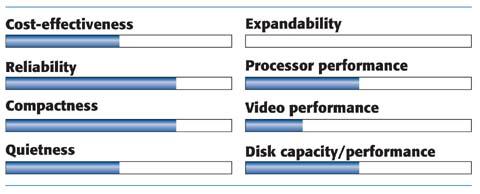Chapter 7. Building a Small Form Factor PC

When the discussion turns to Small Form Factor (SFF) PCs, the first question that comes to our minds is how the term is being used. SFF means different things to different people. For some, it’s any PC smaller than the norm. For others, it’s specifically the “shoebox” form factor—the so-called “cube” systems—pioneered by Shuttle. (In fact, Shuttle says SFF means Shuttle Form Factor). Still others consider any PC built around a microATX motherboard and case to be an SFF system. And some True Believers claim that only systems based on Mini-ITX motherboards—which are so small they can be built into a teddy bear or cigar humidor—qualify as SFF PCs.
We think the best way to define SFF is by case volume. The cubic capacity of standard mini/mid-tower ATX cases ranges from 30 to 50 liters. Typical microATX cases range from 10 to 20 liters. The standard Shuttle SFF case is 200mm x 300mm x 185mm (just under 8” 12”), and has a volume of about 11 liters. Cases designed for Mini-ITX motherboards are smaller still, from 6 to 9 liters. Most people perceive a 20-liter or smaller case as “small” and a 10-liter or smaller case as “tiny.” Any case with a volume of 20 liters or less fits our definition of SFF.
Note
To provide an idea of scale, a cube that contains 20 liters is about 27 cm (10.7”) on a side. A cube that contains 6 liters is about 18 cm (7.2”) ...
Get Building the Perfect PC now with the O’Reilly learning platform.
O’Reilly members experience books, live events, courses curated by job role, and more from O’Reilly and nearly 200 top publishers.

